The Ultimate Guide to Red Light Therapy & Photobiomodulation

Contents
- What is Red Light Therapy orPhotobiomodulation?
- 9 Research-Backed Benefits of Red Light Therapy?
- How to Use Red Light Therapy
- How to Choose a Red Light Therapy Device
- Who can Benefit From Red Light Therapy?
- Final Thoughts
Many people believe that diet, exercise, and supplements are the keys to health. But new research shows that light has incredible health benefits, and red light most of all.
Want to detoxify your body, heal faster, and go through life with more energy and less pain? Try adding some healing red light to your daily regimen.
Keep reading to learn how red light therapy works, its remarkable scientifically-proven benefits, how to choose and use a red light therapy device, who can benefit from red light therapy, and more.
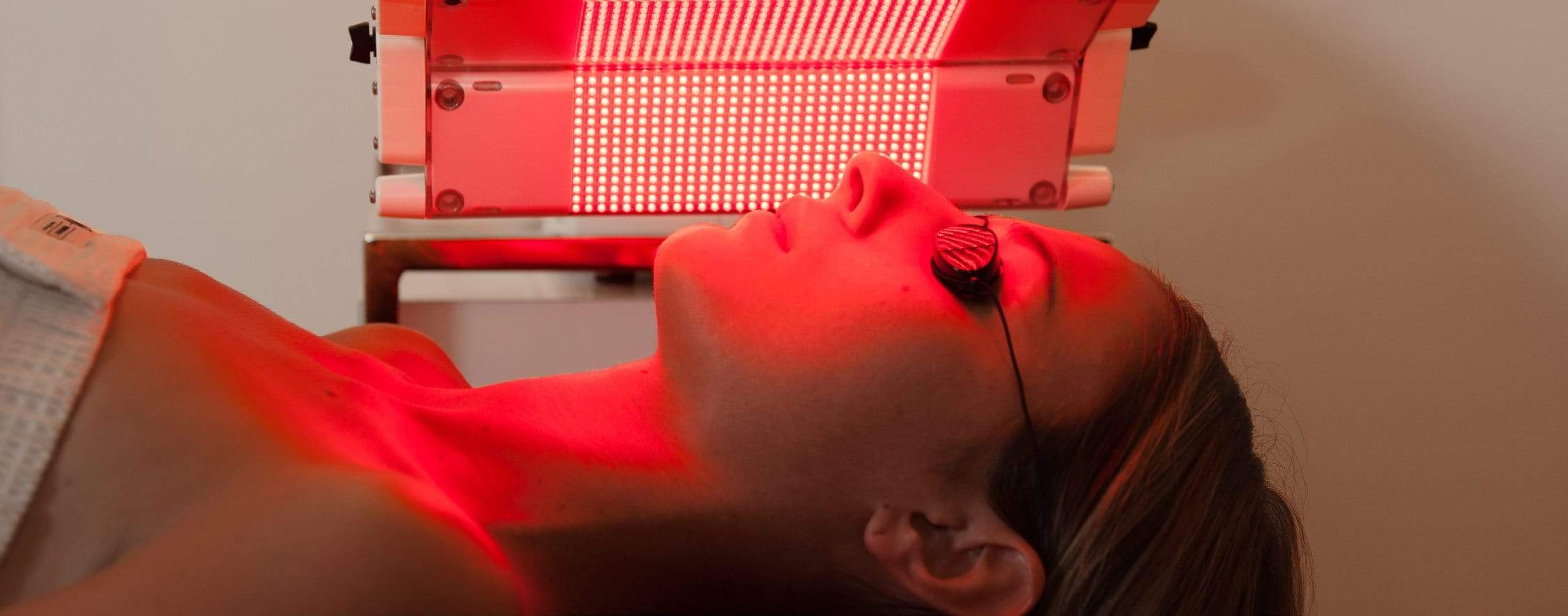
What is Red Light Therapy or Photobiomodulation?
Red light therapy goes by many names.
You may have already heard of red light therapy LED panels, infrared saunas, heat lamps, or photobiomodulation. In essence, all of these devices work on similar principles.
While the various delivery methods differ in their design and effectiveness, all red light therapy relies on the same basic concept: specific colors of red light have measurable, beneficial physical effects in your body.
Visible red light and invisible infrared light transfer energy to your body in the form of both light and heat, but they also affect your cells in other fascinating ways.
Over the past decade and a half, dozens of new scientific studies have shown a variety of health benefits, which we’ll cover in a moment.
As a result of these scientific findings, the availability of safe commercial products for red light therapy is growing.
But to understand why red light therapy is effective for health purposes, we first need to look back in evolutionary history. Way back, in fact, to the origins of life on earth.
How (and Why) Does Red Light Therapy Work?
At the earth’s surface, natural sunlight is about 42% non-visible infrared (IR) light.
In a nutshell, all life on Earth came into existence bathed in large amounts of red light for the past 3.7 billion years (give or take).
Not surprisingly, most living organisms have evolved to take advantage of this abundantly available form of energy.
At a cellular level, red and infrared light appear to interact with heme (iron) pigments that allow the transfer of energy within cells and mitochondria[1].
Along with providing extra energy for cells to use, the light therapy also activates transcription factors that control the activation and inactivation of genes[2].
Some researchers think that water itself, which readily absorbs infrared light within cells, is involved in the mechanisms of red light therapy, too[3].
Wood fires release plenty of red and infrared light, and early human ancestors may have first used fire over a million years ago[4][5]. Next time you relax in a sauna or warm yourself in front of a campfire, keep in mind that you’re continuing a long and healthy tradition first begun long ago by our ancestors.
And another reason relates to recent changes in indoor lighting technology
Tungsten incandescent bulbs or “Edison light bulbs” available for the past 150 years emit 90% of their energy as non-visible infrared light[6].
In other words, incandescent bulbs mostly emit energy in the form of heat, and only 10% of their light is visible.
Modern LEDs and fluorescent bulbs save nearly 90% on energy costs by emitting little or no infrared.
Almost all the energy used for modern lighting goes to the visible spectrum. But these light sources also emit more blue light, which is potentially harmful to your health, and less red light compared to the sun, fire, or specialty bulbs designed to support sleep[7][8].
As companies switch to selling “energy-efficient” bulbs, the result appears to be that we are becoming more and more deficient in red and infrared light.
Along with using light sources that emit an unnatural amount of blue light these days, most people don’t get much sunlight on their naked bodies or spend much time unwinding beside a fire
Those are the most likely reasons why boosting your exposure to red light can have outsized effects on your health in the modern world.
About the Red and Infrared Spectrum
To grasp the health benefits as well as the technical details of red light therapy devices, you need a basic understanding of the red and infrared spectrum.
Nanometers (nm) are a measure based on the visible and nonvisible light spectrum, which refers to the length of each light wave.
The visible light spectrum for the human eye is 380-700 nanometers. Light below 380 nm is ultraviolet (UV), and light above 700 nm is infrared (IR).
In between, in descending order of wavelength, is the spectrum we can see with the naked eye: red, orange, yellow, green, blue, indigo, and violet--or ROYGBIV, as you probably learned in science class.
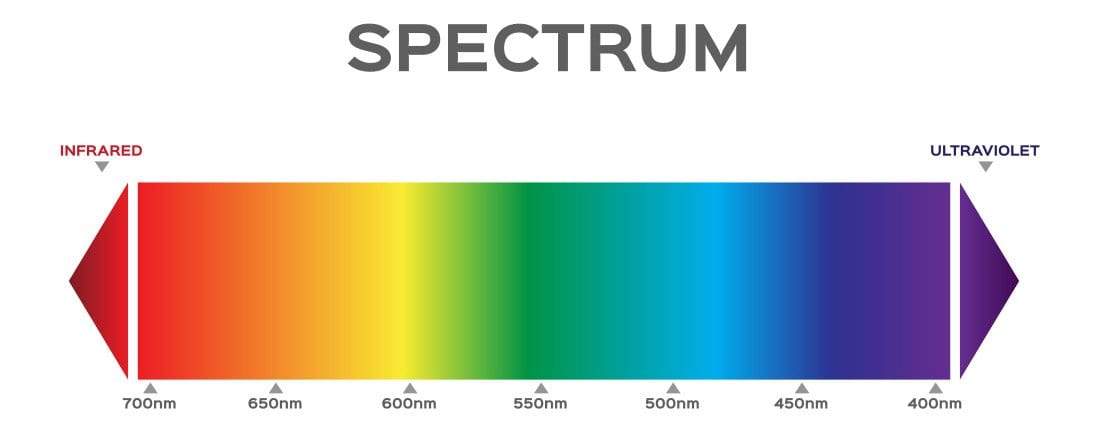
Commercial red light therapy products usually emit light between about 660 and 3000 nanometers. In other words, they produce light beginning in the far end of the visible red spectrum, well into the infrared spectrum.
The infrared spectrum is much larger than the visible light spectrum, which is why it’s further broken down into the following classifications:
- Near-infrared (NIR): Shorter-wavelength, non-visible red light, typically under 1000 nanometers
- Mid-infrared (MIR): Non-visible red light between NIR and FIR, typically greater than 1000 nanometers but under 3000 nanometers
- Far-infrared (FIR): Long-wavelength, non-visible red light, sometimes defined as over 3000 nm[9]
As you might expect, NIR, MIR, and FIR all have different biological effects.
And thanks to modern LED technology, today’s manufacturers can make bulbs that emit precise wavelengths of IR light anywhere along the infrared spectrum.
However, visible red and NIR devices--between about 630 and 1000 nanometers--appear to have more health benefits than the other forms of infrared light therapy, according to current research[10].
Next, we’ll cover the most exciting benefits of red light therapy as recently discovered in scientific research.
9 Research-Backed Benefits of Red Light Therapy
#1: Sweating and Detoxification
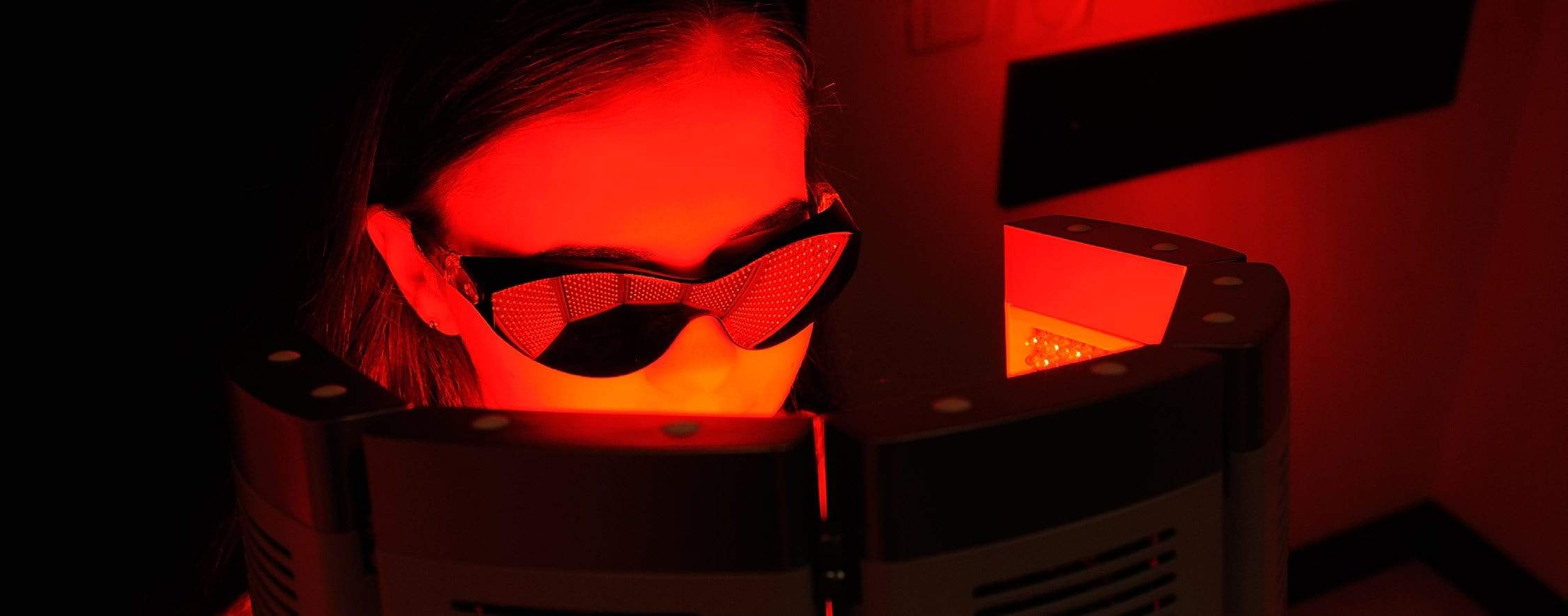
When you sit in front of an infrared light source, it heats your skin. As a result, your body produces more sweat, which may help eliminate heavy metals and other harmful toxins from your body[11][12].
But unlike other methods used to induce sweating, infrared light also creates a special form of water inside your cells, called exclusion zone (EZ) water[13].
EZ water, also called “the fourth phase of water,” was first discovered by Dr. Gerald Pollack. It’s a gel-like substance with a negative electrical charge that can provide energy to your cells.
More importantly for the purpose of detoxification, EZ water also pushes out or “excludes” most particles from cells, allowing your body to sweat out foreign substances more efficiently[14].
With the combination of EZ water and sweating, red light therapy is the perfect choice if you want to safely eliminate toxins from your body.
#2: Faster, Better Healing
Red light therapy might help you heal from injuries more quickly, and it may also support the healing of injuries that your body can’t repair by itself.
Studies of bone cells suggest that near-infrared therapy may help broken bones heal faster, and evidence in humans and mice also show it helps skin wounds close more quickly[15][16][17].
It may also heal the retina and may protect against macular degeneration and other vision problems[18].
And evidence also suggests that in senior citizens and people with type 2 diabetes or other health conditions that impair healing, infrared light may help heal wounds that wouldn’t otherwise heal on their own, potentially saving limbs[19][20].
Unlike many traditional methods of wound-healing, red light is painless, non-invasive, safe, and relatively inexpensive[21].
#3: Younger, Healthier Skin
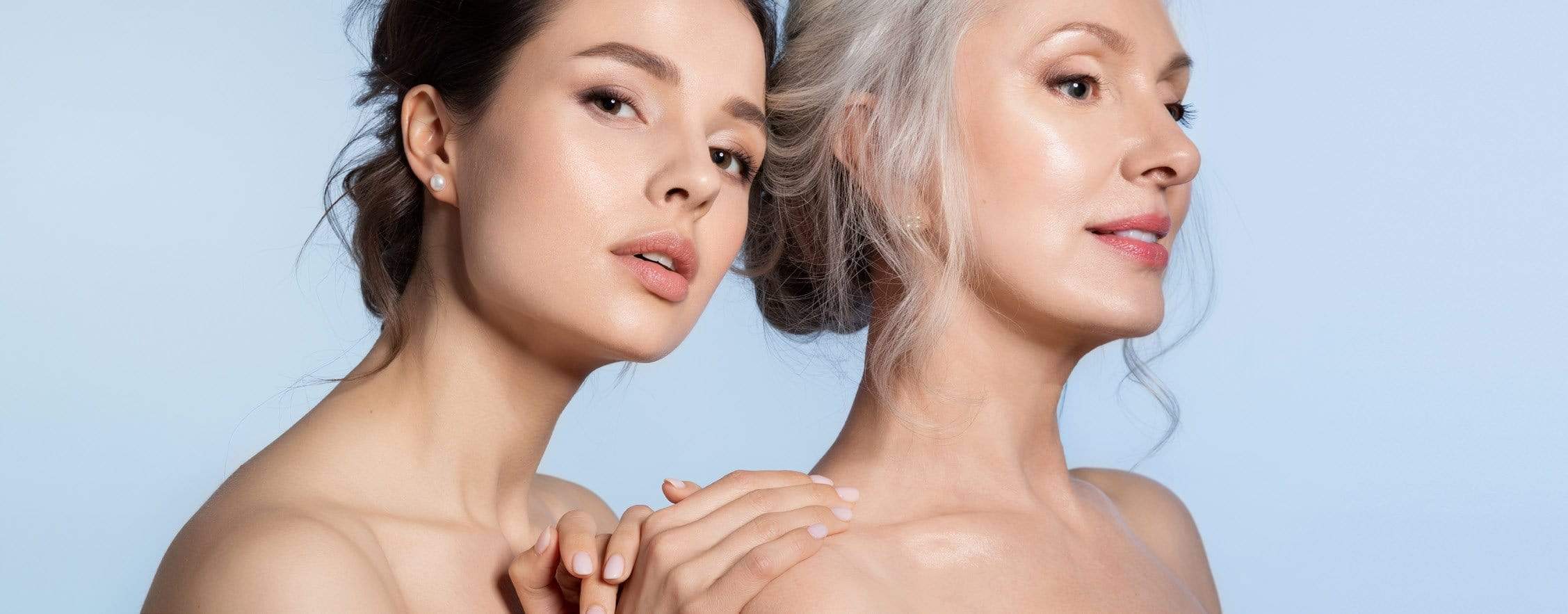
Sweating can clear up your skin all by itself, but red light therapy is about far more than just sweating[22].
Along with healing skin wounds faster, studies suggest that infrared light can hydrate your skin and speed up the production of collagen (the elastic protein that gives your body its shape and structure) in healthy skin [23][24].
As a result, IR therapy may help slow skin aging, reduce the appearance of wrinkles, and even reverse the formation of unsightly cellulite[24].
According to the authors of a peer-reviewed paper on the topic,
“IR radiation increased the amount of total soluble collagen and soluble elastin in fibroblasts and [resulted] in clinical improvement in skin texture....with a mean improvement of 25% to 50% achieved after 6 months of treatment, and roughness and tightness of the skin [and fine wrinkles] improved in all of the 20 patients enrolled in the study” (Emphasis added)[23].
#4: Increased ATP Production and Better Mitochondrial Health
Normally, you may think of energy in your body as coming from the food you eat, but your body also has the ability to make usable energy from light.
Red light therapy increases energy production in your body.
Unless you’re a nerd or a trained scientist this health benefit can be a little bit tricky to grasp at first, but it’s well worth the effort.
Most of the cells in your body have mitochondria, tiny organelles that produce energy using protons, electrons, and oxygen to fuel cellular processes throughout your body
Mitochondria create adenosine triphosphate (ATP), an energy storage molecule, by stripping electrons from hydrogen and saving them for later. Whenever your body needs more energy, your cells break down stored ATP to free up electrons and fuel themselves.
So where do red and infrared light fit into this process?
Your mitochondria also have a pigment called Cytochrome C Oxidase (CCO for short). It’s also known as Subunit 4 of the mitochondria.
CCO absorbs infrared light, and when it does, it increases ATP production by up to 350%--without requiring additional food or calories[25]!
Other evidence suggests that changes in cell water viscosity (thickness) caused by IR light are more important than Cytochrome C Oxidase for increasing energy production, but the end result is the same when it comes to ATP[3].
However, this energizing effect only occurs within the wavelengths between 600 to 1000 nanometers.
To sum up, you need visible red light or near-infrared (NIR) light to boost ATP production and provide “free” energy to cells[26]. Mid- and far-infrared won’t do the trick.
Bottom line: the increase in ATP production helps explain why red light therapy has such a wide variety of healing effects. By providing impaired or damaged cells with more energy, those cells gain the ability to heal themselves more effectively in the presence of red and infrared light.
#5: Decreased Pain

If you’ve got issues like arthritis, chronic pain, or neuropathic pain, scientific studies suggest that red light therapy can help.
Infrared light reduces inflammation and autoimmune activity in your body, and researchers have found that it’s effective for relief from chronic pain[27][28].
Most importantly red light therapy is safe for treating pain and doesn’t cause nerve damage[29].
#6: More Nitric Oxide
When you expose your bare skin to infrared light, it boosts the production of nitric oxide[30].
Nitric oxide is a gas that acts as a signaling chemical in your body. It causes your blood vessels to dilate, and it also controls neurotransmitter levels in your brain and nervous system.
Here’s what more nitric oxide from red light therapy means, practically speaking:
- Reduced blood pressure[31][32]
- Better cardiovascular health, even after a heart attack[33]
- Enhanced sexual function (particularly for men, and possibly in women)[34][35]
- Higher levels of “feel-good” chemicals like dopamine and serotonin[36]
Low levels of nitric oxide have been linked to high blood pressure, inflammation, and depression, so if you deal with those health conditions, red light therapy could be a fantastic choice to feel better and improve your overall health[37].
#7: Better Brain Health

When you consider that red light therapy boosts energy production and raises neurotransmitter levels, the fact that it’s also healthy for your brain should hardly come as a surprise.
In people with neurodegenerative conditions, strokes, or traumatic brain injuries, data suggests infrared light can accelerate brain healing--provided it’s powerful enough to penetrate the skull[38][39][40][41].
And because red light therapy can help prevent the death of neurons, some scientists think there’s also a chance that it can help keep your brain healthy during aging, and may help prevent degenerative conditions like Parkinson’s and Alzheimer’s[38].
Finally, evidence also suggests red and infrared light can help benefit people with depression, anxiety, and PTSD[42].
#8: Improved Recovery and Athletic Performance
If you’re an athlete or fitness enthusiast, red light therapy can help you recover faster and may even boost your physical performance.
In the same way it stimulates healing and regeneration in damaged tissues, IR light can accelerate the repair of damaged muscle cells after a workout. It also speeds up the clearance of cellular waste products that build during exercise[43].
According to peer-reviewed data, red light therapy can increase muscle mass, reduce muscle stress, and decrease inflammation[44].
And not only that, but it can increase your endurance and help you perform more reps during workouts[43].
In fact, because it’s highly effective at increasing performance, some scientists have actually questioned whether red and infrared light should be banned for high-level competitive athletes[44]!
You can use red light therapy before or after exercise. If you want to increase your performance, try it preexercise, but if you want to recover more quickly, do it afterwards.
#9: Greater Oxygenation

Adequate oxygen is an absolute necessity for most life on Earth. You can only survive about three minutes without breathing.
While the importance of breathing oxygen to stay alive might be self-evident, it’s also true that the amount of oxygen in your body has a direct impact on your health.
Chronic hypoxia, a condition in which your red blood cells or tissues don’t receive enough oxygen, is associated with conditions including:
How can you improve your O2 levels?
While deep breathing techniques and getting plenty of fresh air are effective and worthwhile methods, red light therapy is another way to support the oxygenation of blood and tissues in your body[49][50][51][52].
When you expose your skin to near-infrared light, the result is that your red blood cells can carry more oxygen to your tissues[52].
And according to a study of healthy men and women, infrared light on your forehead can increase oxygen levels in your brain[53].
Other research suggests higher oxygen levels lead to better cognitive function immediately, and even support brain healing when sustained over time[54][40].
The takeaway? If you want to experience the cognitive and health benefits of high oxygen saturation, try combining your red light therapy sessions with slow, rhythmic breathing in fresh, unpolluted air.
How to Use Red Light Therapy
If you’ve never tried red light therapy before, the single most important thing is to start slowly.
You can achieve benefits in as little as four to ten minutes, but some people may experience minor adverse effects when starting out[55].
If you notice nausea, dizziness, or other symptoms, speak to your doctor. You may choose to start with even less red light therapy--as little as one to two minutes at a time.
Over time, you can work your way up to sessions of twenty to thirty minutes, but don’t rush it! Always make sure you’re well-hydrated first, and pay attention to how you feel during each session.
If you love the way red light therapy makes you feel, you can use it for up to an hour per day (in several divided sessions), but don’t overindulge.
Studies show that too much infrared light can have the opposite effect of a therapeutic dose[56].
If you overdo it, red light therapy is less effective and may even be detrimental. Sometimes, less is more!
Clothing, cosmetic products, makeup, and oil prevent your skin from absorbing infrared light. For best results, make sure your skin is bare and clean.
And if you sweat during your session, don’t forget to rinse off afterwards to get rid of any toxins you eliminated.
How to Choose a Red Light Therapy Device
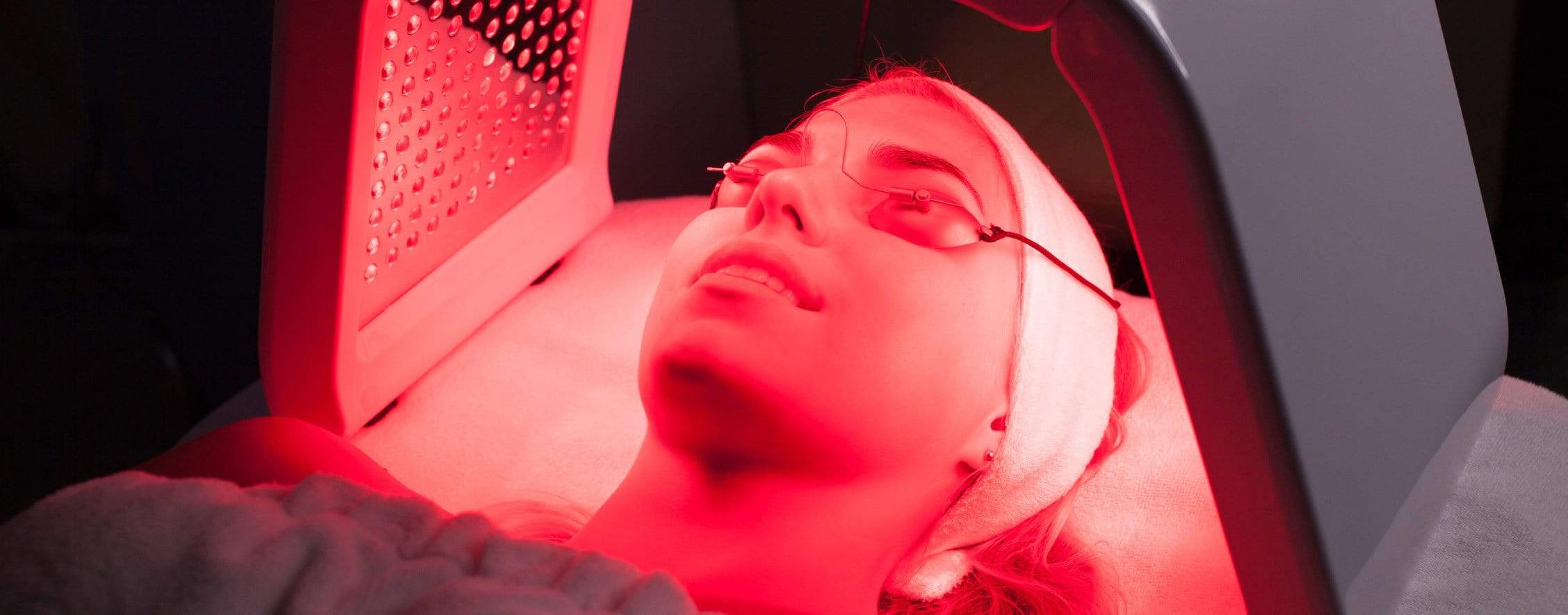
There are plenty of red light therapy devices on the market, but they’re not all created equal.
The light frequency emitted by a product is the single most important aspect to consider before you make a purchase.
You can find near-, mid-, and far-infrared (NIR, MIR, and FIR) devices, but as we already discussed, the majority of the benefits come from visible red and invisible near-infrared ligh
To get the full health effects of red and near-infrared light, choose a product that emits light in the range of 660-1000 nanometers. If the manufacturer doesn’t clearly state the frequency of their red light therapy device, look elsewhere.
Further, the type of bulb or emitter also affects the performance of the device. The most common designs use either an incandescent bulb or light-emitting diode (LED).
With modern LED fixtures, you can know the precise wavelength of light, and in some cases even adjust the output according to your goals. And they may offer a longer lifespan and greater energy-efficiency compared to incandescent.
However, most LEDs also emit flickering light that’s less than ideal, and potentially even unhealthy.
Your body isn’t adapted to flickering light sources because they don’t occur in nature, and they can have negative health consequences regardless of the wavelength of light[57][58][59].
Here’s what else to look for before you make a purchase:
- Portability (units range from travel-sized to enclosed saunas requiring professional installation)
- Self-cooled for fire safety and personal comfort
- Low in “dirty electricity” and other non-native electromagnetic fields (EMFs)
- No Wi-Fi, Bluetooth, or digital timers that increase non-native EMF exposure
Unlike most red light therapy devices, the Mito Wellness Panel from NourishMe Organics has adjustable output that lets you Choose Your Wavelength. Just flick the appropriate switch to control the two frequencies of 660 nm visible red light for increased collagen production and optimal skin health, or 850 nm NIR light for deep healing.
The Mito Wellness Panel also uses a special inverter to minimize LED flicker. It’s portable, fan-cooled, and extremely low-EMF without Wi-Fi, Bluetooth, or digital timers.
Alternatives to Purchasing Your Own Device
A high-quality, safe red light therapy device can be a significant investment. Here are two other options that can allow you to gauge the benefits for yourself, prior to making a purchase.
First, you can look for red light therapy spas in your area, , and some gyms also offer red light therapy as part of their memberships.
Make sure to inquire as to the specific frequencies before you buy a membership. Mid- and far-infrared light can heat up your body and make you sweat, but remember: you need visible red and near-infrared light (660-1000 nm) for the full range of health benefits.
And as you learned earlier, the sun is about 42% infrared, and it’s free to use as much as you want. Check out the next section for some tips on how to get a healthy dose of red and infrared light from the sun!
Sunlight is 42% Red Light — Here’s How to Use It as Therapy
Even if you don’t own a red light therapy device yet, you can use the sun to improve your health and wellness and achieve many of the benefits of red light therapy
No matter the weather, direct natural light outdoors provides you with a hefty dose of red and infrared light.
Natural light also normalizes your body’s circadian rhythms, helping you feel more awake during the day and sleep better at night[60].
But keep in mind that clothing, sunscreen, makeup, oils, and glass windows all block infrared light to varying degrees--for best results, strip down as much as possible before you go outside.
When it comes to using the sun for red light therapy, the time of day is another important consideration.
Sunrise, sunlight between 7 A.M. to 10 A.M., and sunlight after 4 P.M. have lots of red and infrared light and less ultraviolet, but the ultraviolet light at mid-day and solar noon can also complement the benefits of natural red light and boost your vitamin D levels.
If you aren’t experienced with sunbathing, start with mornings and evenings to avoid burning. You can add more natural light at other times of day gradually.
Lastly, cloudy days tend to have more infrared (relative to other types of light) and somewhat less UV, so they’re an excellent opportunity to max out your natural red light therapy exposure.
Who Can Benefit From Red Light Therapy?
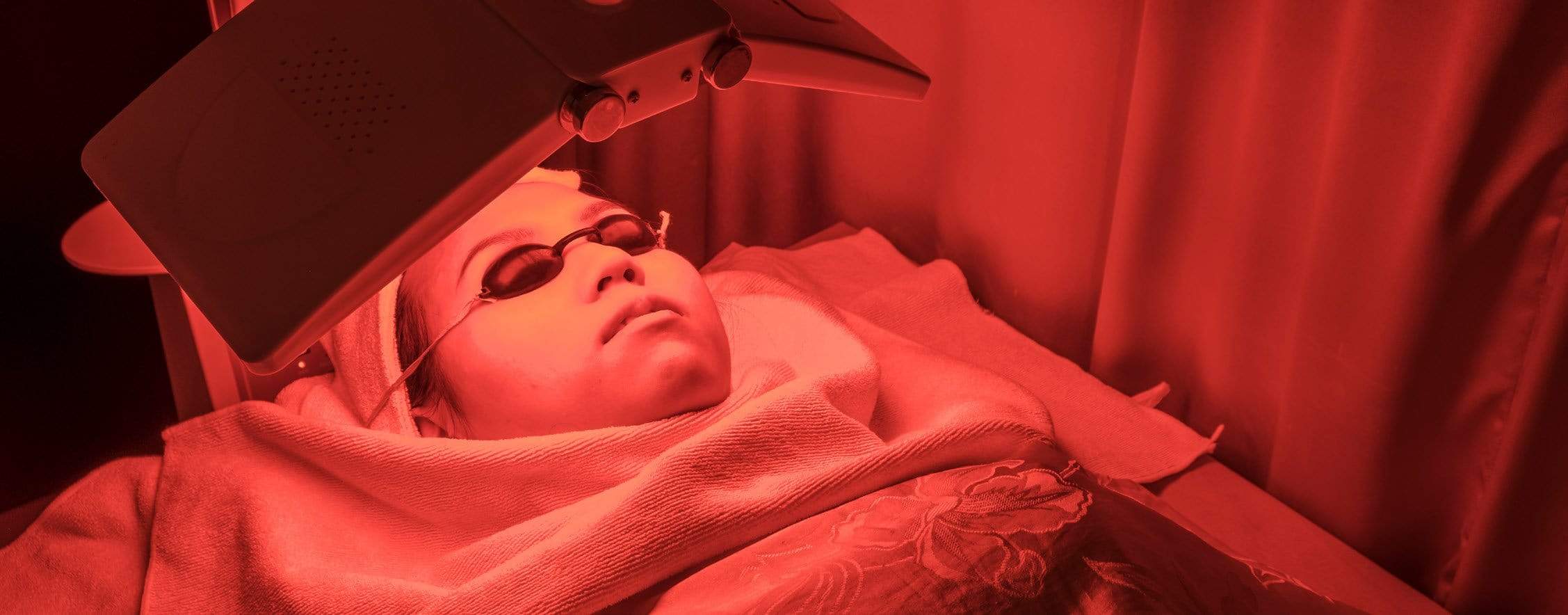
Red light therapy offers something for everyone. It doesn’t cause sunburn (in fact, it may help prevent sunburn from UV light), and scientific studies have found no serious or long-term side effects[61]
Regardless of your age, fitness, and health history, you should definitely consider red light therapy if you want to:
- Detoxify your body
- Heal faster or heal old injuries
- Achieve smoother, younger skin
- Reduce chronic pain or neuropathic pain
- Improve your mental function and brain health
- Recover from physical activity more quickly and enhance your fitness
But just to be on the safe side, you should speak to your physician first before using red light therapy. This is especially true if you take prescription drugs, have health problems or a history of illness, or haven’t had a medical exam recently
And be sure to temporarily avoid red light therapy if you’ve had alcohol, ingested drugs, or haven’t hydrated properly.
Final Thoughts
Whether you want to detox, improve healing, or simply boost your energy levels, red light therapy is worth a try.
The peer-reviewed research points to numerous positive health effects, and the odds are high that more benefits will be discovered in the near future.
Luckily, now you can experience it for yourself if you want to see how well red light therapy works.
The convenient, portable, and safe the Mito Wellness Panel is on sale for a limited time. It’s the only unit that allows you to Choose Your Wavelength.
It features an adjustable output between 660-1000 nanometers, with a special one-of-a-kind power inverter to minimize LED flicker.
And unlike other red light therapy units, the Mito Wellness Panel is fan-cooled and extremely low-EMF without unnecessary Wi-Fi or Bluetooth features.















